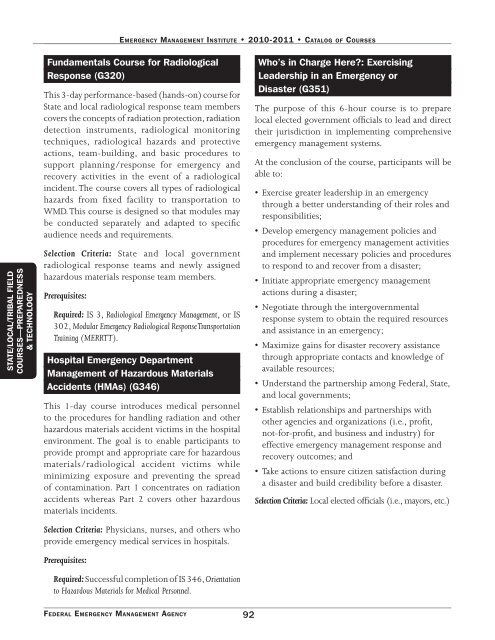enrollment for emi courses - Emergency Management Institute ...
enrollment for emi courses - Emergency Management Institute ...
enrollment for emi courses - Emergency Management Institute ...
Create successful ePaper yourself
Turn your PDF publications into a flip-book with our unique Google optimized e-Paper software.
statE/lOcal/trIbal fIElD<br />
cOursEs—prEparEDnEss<br />
& tEcHnOlOgy<br />
EmE r g E n c y ma n a g E m E n t In s t I t u t E • 2010-2011 • ca t a l o g of co u r s E s<br />
fundamentals course <strong>for</strong> radiological<br />
response (g320)<br />
This 3-day per<strong>for</strong>mance-based (hands-on) course <strong>for</strong><br />
State and local radiological response team members<br />
covers the concepts of radiation protection, radiation<br />
detection instruments, radiological monitoring<br />
techniques, radiological hazards and protective<br />
actions, team-building, and basic procedures to<br />
support planning/response <strong>for</strong> emergency and<br />
recovery activities in the event of a radiological<br />
incident. The course covers all types of radiological<br />
hazards from fixed facility to transportation to<br />
WMD. This course is designed so that modules may<br />
be conducted separately and adapted to specific<br />
audience needs and requirements.<br />
Selection Criteria: State and local government<br />
radiological response teams and newly assigned<br />
hazardous materials response team members.<br />
Prerequisites:<br />
Required: IS 3, Radiological <strong>Emergency</strong> <strong>Management</strong>, or IS<br />
302, Modular <strong>Emergency</strong> Radiological Response Transportation<br />
Training (MERRTT).<br />
Hospital <strong>Emergency</strong> Department<br />
management of Hazardous materials<br />
accidents (Hmas) (g346)<br />
This 1-day course introduces medical personnel<br />
to the procedures <strong>for</strong> handling radiation and other<br />
hazardous materials accident victims in the hospital<br />
environment. The goal is to enable participants to<br />
provide prompt and appropriate care <strong>for</strong> hazardous<br />
materials/radiological accident victims while<br />
minimizing exposure and preventing the spread<br />
of contamination. Part 1 concentrates on radiation<br />
accidents whereas Part 2 covers other hazardous<br />
materials incidents.<br />
Selection Criteria: Physicians, nurses, and others who<br />
provide emergency medical services in hospitals.<br />
Prerequisites:<br />
Required: Successful completion of IS 346, Orientation<br />
to Hazardous Materials <strong>for</strong> Medical Personnel.<br />
FEd E r A L Em E r g E N C y mA N A g E m E N T Ag E N C y 92<br />
who’s in charge Here?: Exercising<br />
leadership in an <strong>Emergency</strong> or<br />
Disaster (g351)<br />
The purpose of this 6-hour course is to prepare<br />
local elected government officials to lead and direct<br />
their jurisdiction in implementing comprehensive<br />
emergency management systems.<br />
At the conclusion of the course, participants will be<br />
able to:<br />
• Exercise greater leadership in an emergency<br />
through a better understanding of their roles and<br />
responsibilities;<br />
• Develop emergency management policies and<br />
procedures <strong>for</strong> emergency management activities<br />
and implement necessary policies and procedures<br />
to respond to and recover from a disaster;<br />
• Initiate appropriate emergency management<br />
actions during a disaster;<br />
• Negotiate through the intergovernmental<br />
response system to obtain the required resources<br />
and assistance in an emergency;<br />
• Maximize gains <strong>for</strong> disaster recovery assistance<br />
through appropriate contacts and knowledge of<br />
available resources;<br />
• Understand the partnership among Federal, State,<br />
and local governments;<br />
• Establish relationships and partnerships with<br />
other agencies and organizations (i.e., profit,<br />
not-<strong>for</strong>-profit, and business and industry) <strong>for</strong><br />
effective emergency management response and<br />
recovery outcomes; and<br />
• Take actions to ensure citizen satisfaction during<br />
a disaster and build credibility be<strong>for</strong>e a disaster.<br />
Selection Criteria: Local elected officials (i.e., mayors, etc.)

















